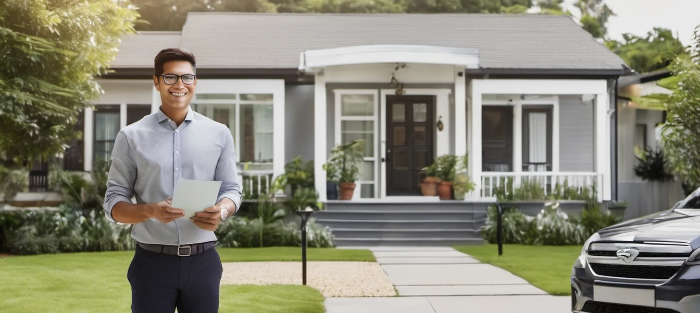Choosing The Right Neighborhood

Fall in love with a house, but verify the neighborhood. The street you buy on will shape your daily rhythm, your safety, your commute, your resale value—everything. Granite counters won’t fix a location that works against you. So before you sign, get tactical: read the signals, pressure-test assumptions, and choose a neighborhood that makes life easier now and pays you back later.
Read the Pulse, Not the Postcard
Every neighborhood sits somewhere on a curve—rising, stable, or slipping. Don’t guess. Walk it. Talk to people on porches, baristas, delivery drivers. Scan for fresh permits on windows, dumpsters in driveways (renovations), new storefront build-outs, and fenced construction sites. Those are “money is moving” signals. Also note the opposite: boarded retail, frequent police tape, or long-vacant houses. Transitional areas can be gold, but only if improvement is proven and compounding—not just promised.
Price Check with Context
Comps matter, but context matters more. Look at recent sales on the same micro-block, not just the zip. Compare lot size, condition, and days on market. A bargain next to chronic vacancies isn’t a bargain. Ask your agent for a comp set that includes pendings and withdrawals—you want to know what didn’t sell and why. If distressed sales dominate, your “deal” may simply be the going rate for the risk profile of that street.
Schools: Even If You Don’t Have Kids
School quality has a gravitational pull on prices and buyer demand. High-performing districts tend to soften downside risk and widen your future buyer pool. Read reviews, check district plans, and drive the pickup line at dismissal to feel the culture. If you’re child-free, remember: you’re still investing in the demand drivers that will help you exit cleanly when it’s time to sell.
Noise, Traffic, and Daily Rhythm
Visit at 7:30 a.m., lunchtime, and late evening. That “quiet” block at noon might turn into a cut-through at 5 p.m., a club spillover at 11 p.m., or a church-parking takeover on Sundays. Listen for flight paths, train horns, sirens, HVAC farms behind grocery stores, and delivery trucks backing up at dawn. If you need windows closed and headphones on just to relax, you’re paying a daily tax you didn’t budget for.
Infrastructure Tells the Truth
Streets and sidewalks are a neighborhood’s résumé. Smooth pavement, maintained curbs, usable sidewalks, lighting that actually lights, and visible storm drains all signal care and funding. Add proximity and reliability of transit if you’ll use it, plus distance to hospitals, fire stations, and grocery stores. Emergency response times aren’t listed on a flyer, but the distance to services quietly shapes both safety and insurance realities.
Safety: What You See and What You Verify
Trust your senses, then verify. Are there eyes on the street or does everyone retreat behind privacy fences? Do porches feel used or abandoned? Fresh graffiti that lingers, busted lights, and unsecured vacant houses are signals. Ask neighbors candidly where they feel comfortable walking at night and why. Then pull crime stats from official sources and compare block to block. A single intersection can change the story.
Commute and Convenience Are Equity
A “deal” that steals two hours a day isn’t a deal. Drive your actual commute during rush hour. Try the school run. See what a grocery dash looks like at 6 p.m. If transit, biking, or walking are part of your plan, run the route. The closer your daily life lines up with reality, the more you’ll actually use and enjoy the home you’re buying—and the less likely you are to sell under stress later.
“Buy the neighborhood that makes your life work today—and protects your equity tomorrow.”
Amenities vs. Lifestyle Fit
Restaurants, parks, trails, gyms, and libraries are fantastic—if you’ll use them. Match the amenity map to your calendar. If your week is kids’ sports plus early mornings, a late-night district under your bedroom window is a mismatch. If you’re remote-first, maybe you want coffee within a five-minute walk and a park bench with morning sun. Buy for the life you live, not the life a brochure suggests.
Condition Signals Future Value
Scan lawns, paint, roofs, porches, and fences. Consistent pride of ownership compounds. Deferred maintenance also compounds—just in the wrong direction. Pocket parks, medians, and HOA/common-area care are leading indicators: if shared spaces look good, owners are engaged. If they’re neglected, sellers are likely squeezing pennies, and you may be the one funding the turnaround without the upside.
Red Flags Worth Walking Away From
- Chronic vacancies or squatters within a two-block radius.
- Unresolved drainage issues (watch after rain) or frequent street flooding.
- Commercial creep that’s out of sync with residential hours.
- Promised large projects with no permits, plans, or community updates.
- Wildly inconsistent comps that suggest unstable demand.
The 90-Minute Field Test
Don’t just tour—“live” there for an hour and a half. Park and walk ten minutes in each direction. Count “hellos.” Note dog walkers at dusk. Sit in the car with windows down. Check cell coverage. Order takeout and time delivery. Drive the grocery route. If you’re bored, bothered, or uneasy during the test, the honeymoon won’t fix it. If you feel yourself exhale, you’ve found something worth pursuing.
Decide With Both Head and Gut
Smart buyers make two lists: non-negotiables (safety, commute, school preference, noise tolerance) and nice-to-haves (views, trendy retail, specific builders). If a neighborhood hits your non-negotiables and at least 80% of the nice-to-haves, move forward. If it misses a non-negotiable, stop. Your future self will thank you. Bring your agent into the process early and ask for pressure-testing: “What am I not seeing? What would you worry about on resale?”
Bottom line: the right neighborhood lets your life work better today and protects your equity tomorrow. Don’t accept “good enough.” Do the legwork, trust the data, and choose the place that supports the way you live—and the future you’re building.
Related pages you might like
Smart strategies, checklists, and insider advice to buy with confidence.
Budget, red flags, pre-approval, and the key steps to buy smart.
Clarify your non-negotiables and avoid costly “nice-to-have” traps.
If you’re a buyer, this article helps you make smarter decisions. If you’re an agent, this is the kind of content that builds trust and converts leads. Get 24 more articles like this in our bundle.
Home > Real Estate Articles >> Real Estate Articles for Buyers >> Choosing The Right Neighborhood

